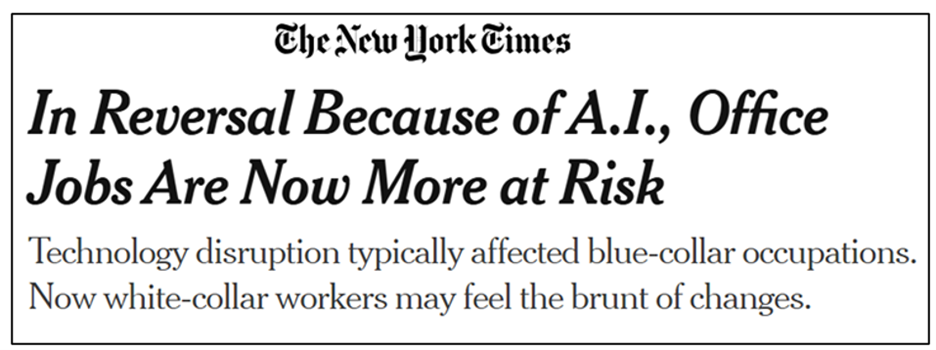 |
| By Nilus Mattive |
At the beginning of the year, IMF Chief Kristalina Georgieva issued a dire warning ahead of the World Economic Forum in Davos, Switzerland.
It wasn’t about soaring government debts or a particular country’s finances. It was about AI.
Specifically, she said:
“In most scenarios, AI will likely worsen overall inequality, a troubling trend that policymakers must proactively address to prevent the technology from further stoking social tensions.”
Georgieva went on to suggest that AI could affect up to 40% of jobs around the world. And as she noted, unlike past technological revolutions, white collar workers were directly in the crosshairs.
In fact, the IMF conducted a full study on AI’s impact on the global workforce. It concluded:
“In advanced economies, about 60% of jobs may be impacted by AI. Roughly half the exposed jobs may benefit from AI integration, enhancing productivity. For the other half, AI applications may execute key tasks currently performed by humans, which could lower labor demand, leading to lower wages and reduced hiring. In the most extreme cases, some of these jobs may disappear.”
So, one-third of America’s workforce — particularly higher-paid, more highly educated employees — could either see lower wages or outright job losses as AI becomes more commonplace.
It isn’t just the IMF saying this, either.
As a recent New York Times headline declared — “In Reversal Because of AI, Office Jobs Are Now More at Risk.”

And a Barron’s article explained it this way:
“The rise of generative artificial intelligence heralds a new stage of the Industrial Revolution, one where machines think, learn, self-replicate and can master many tasks that were once reserved for humans. This phase will be just as disruptive — and transformative — as the previous ones.
“That AI technology will come for jobs is certain. The destruction and creation of jobs is a defining characteristic of the Industrial Revolution. Less certain is what kind of new jobs — and how many — will take their place.”
It’s true. There’s no doubt that AI will create new jobs as well. The physical infrastructure alone will require all types of construction — everything from electrical work to sophisticated HVAC systems.
But once the initial buildout takes place, even much of that demand will disappear.
Meanwhile, even if other new, more permanent job categories are created — think, thousands of new server maintenance positions — these types of rapid shifts can leave plenty of people out in the cold.
And the longer you’ve been in a certain occupation, the harder it will be to get retrained and back on track.
Outright job losses are already happening, too.
Consider CVS’ decision in early October to cut 3,000 positions while simultaneously saying it would be investing more heavily in AI to cut billions in costs going forward.
Or what about Amazon?
AI-driven robots already comprise one-third of the company’s current workforce. And the company is adding 1,000 more a day.
According to ARK investment fund CEO Cathie Wood, Amazon will use more robots than human employees by 2030.
Yet, this is not just about self-driving forklifts stacking pallets in large warehouses.
Many proponents have a much more extreme vision of humanoid robots literally doing jobs currently reserved for actual people.
In fact, you might be surprised to learn that two of Tesla’s “Optimus” humanoid robots are already working at the company’s factory in Fremont, California.
Elon Musk has said that number will rise to a few thousand by next year. Ultimately, he believes the demand for the company’s robots could make Tesla a $25 trillion company.
And Tesla is just one of several firms making rapid advances in the humanoid robot arena.
Others include Figure, backed by ChatGPT’s parent company, OpenAI.
There’s also Apptronik, with a robot model called Apollo. It recently learned how to perform a task by watching a real human do it.

Whether that excites or scares you, things will continue developing quite rapidly.
Nvidia is building an entire product suite to power these robots, and hundreds of millions in venture capital is pouring into the space.
Goldman Sachs says we could see millions of humanoid robots replacing humans every single year going forward, especially in places like car factories and in dangerous occupations such as search and rescue.
All told, Goldman believes AI — robots and otherwise — will replace 300 million jobs globally.
Elon Musk has gone much further, saying …
“There will come a point where no job is needed — you can have a job if you want one for personal satisfaction — but AI will do everything.”
Whether or not that proves true, there’s no doubt that a seismic shift is already underway.
I urge you to check out Dr. Martin Weiss’ new presentation that lays out four steps you can take right now to prepare … even if your job isn’t on the line.
Best wishes,
Nilus Mattive

